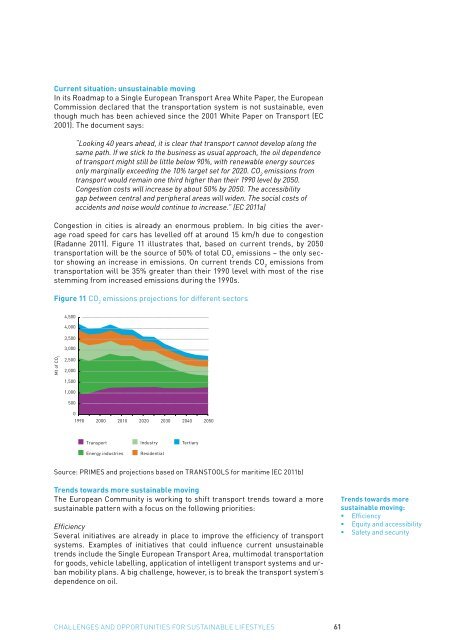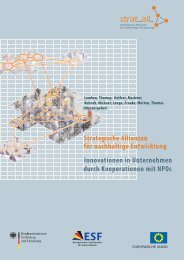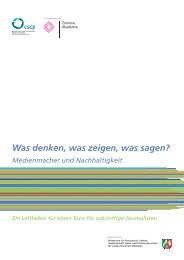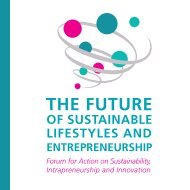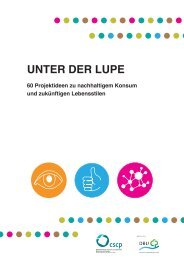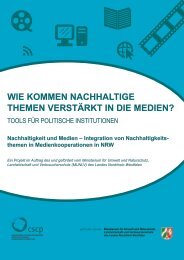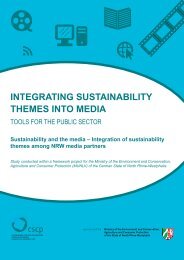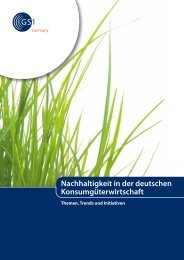today's facts & tomorrow's trends - SPREAD Sustainable Lifestyles ...
today's facts & tomorrow's trends - SPREAD Sustainable Lifestyles ...
today's facts & tomorrow's trends - SPREAD Sustainable Lifestyles ...
You also want an ePaper? Increase the reach of your titles
YUMPU automatically turns print PDFs into web optimized ePapers that Google loves.
Current situation: unsustainable moving<br />
In its Roadmap to a Single European Transport Area White Paper, the European<br />
Commission declared that the transportation system is not sustainable, even<br />
though much has been achieved since the 2001 White Paper on Transport (EC<br />
2001). The document says:<br />
“Looking 40 years ahead, it is clear that transport cannot develop along the<br />
same path. If we stick to the business as usual approach, the oil dependence<br />
of transport might still be little below 90%, with renewable energy sources<br />
only marginally exceeding the 10% target set for 2020. CO 2<br />
emissions from<br />
transport would remain one third higher than their 1990 level by 2050.<br />
Congestion costs will increase by about 50% by 2050. The accessibility<br />
gap between central and peripheral areas will widen. The social costs of<br />
accidents and noise would continue to increase.” (EC 2011a)<br />
Congestion in cities is already an enormous problem. In big cities the average<br />
road speed for cars has levelled off at around 15 km/h due to congestion<br />
(Radanne 2011). Figure 11 illustrates that, based on current <strong>trends</strong>, by 2050<br />
transportation will be the source of 50% of total CO 2<br />
emissions – the only sector<br />
showing an increase in emissions. On current <strong>trends</strong> CO 2<br />
emissions from<br />
transportation will be 35% greater than their 1990 level with most of the rise<br />
stemming from increased emissions during the 1990s.<br />
Figure 11 CO 2<br />
emissions projections for different sectors<br />
4,500<br />
4,000<br />
3,500<br />
3,000<br />
Mt of CO 2<br />
2,500<br />
2,000<br />
1,500<br />
1,000<br />
500<br />
0<br />
1990 2000 2010 2020 2030 2040 2050<br />
Transport<br />
Energy industries<br />
Industry<br />
Residential<br />
Tertiary<br />
Source: PRIMES and projections based on TRANSTOOLS for maritime (EC 2011b)<br />
Trends towards more sustainable moving<br />
The European Community is working to shift transport <strong>trends</strong> toward a more<br />
sustainable pattern with a focus on the following priorities:<br />
Efficiency<br />
Several initiatives are already in place to improve the efficiency of transport<br />
systems. Examples of initiatives that could influence current unsustainable<br />
<strong>trends</strong> include the Single European Transport Area, multimodal transportation<br />
for goods, vehicle labelling, application of intelligent transport systems and urban<br />
mobility plans. A big challenge, however, is to break the transport system’s<br />
dependence on oil.<br />
Trends towards more<br />
sustainable moving:<br />
• Efficiency<br />
• Equity and accessibility<br />
• Safety and security<br />
Challenges and opportunities for sustainable lifestyles 61


